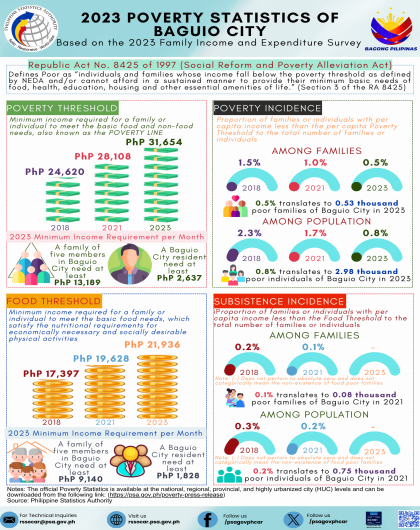The Philippine Statistics Authority (PSA) releases the 2023 Full Year Official Poverty Statistics based on the results of the 2023 Family Income and Expenditure Survey (FIES). The 2023 Full Year Official Poverty Statistics was initially released on 22 July 2024 covering data at the national level. The updated report includes poverty estimates disaggregated at regional, provincial, and highly urbanized city levels.
Poverty threshold in CAR increases but poverty incidence among families decreases
The poverty threshold of the Cordillera Administrative Region (CAR) in 2023 was estimated at PhP13,239 monthly for a family of 5, or PhP435 per day. This was a PhP2,861 or a 27.6% increase compared to the poverty threshold in 2018, and a PhP1,446 or a 12.3% increase compared to 2021. However, the threshold was lower compared to the threshold of the country estimated at PhP13,873. In terms of the percentage of increase in the poverty threshold, the region recorded a higher increase with 13.6% compared to the country with an 11.5% increase from 2018 to 2021. It was a different case from the year 2021 to 2023, as the country had a larger increase with 15.6% compared to CAR with a 12.3% increase.
Table 1. Poverty Threshold for a Family of 5 (in PhP) by Province and HUC, CAR:
2018, 2021 & 2023
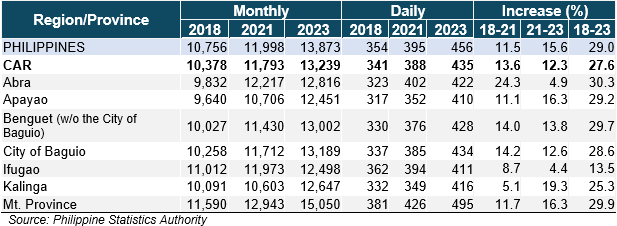
Out of all the provices, Apayao listed the lowest poverty threshold with PhP12,451 monthly, followed by Ifugao with PhP12,498 and Kalinga with PhP12,647. Meanwhile, Mountain Province had the highest monthly per family poverty threshold with PhP15,050, followed by the City of Baguio with PhP13,189 and Benguet with PhP13,002 in 2023. However, in terms of growth rate, Ifugao had the lowest increase in poverty threshold with only 4.4% increase compared to CY 2021, followed by the province of Abra with 4.9% increase. In fact, these two provinces out of all the provinces of CAR showed single digit percent increases in their poverty thresholds from 2021-2023, while the other provinces/HUCs exhibited two-digit percent increases. It is also worth noting that the provinces have a significant increase in the poverty thresholds from 2018-2023 with majority of them having an increase of approximately 25% to 30%. Only the province of Ifugao had tamed increment with 13.5% increase in the poverty threshold.
Figure 1. Poverty Incidence Among Families (%), Philippines and CAR:
2018, 2021 & 2023
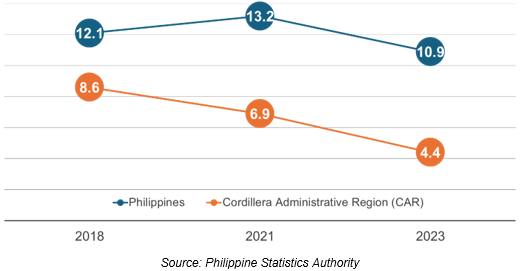
Poverty incidence among families decreased in both the region and the nation overall. From 8.6% incidence rate in CAR for the year 2018 and 6.9% incidence rate for 2021, the incidence rate has dropped to 4.4% in 2023. However, for the Phlippines as a whole, the incidence rate has increased from 12.1% in 2018, to 13.2% incidence in 2021. This was due to the COVID-19 pandemic causing a rife economic setback for the nation. Fortunately, the nation has been recovering since then, with the poverty incidence dropping by 2.3 percentage points to 10.9% poverty incidence among families in 2023.
Table 2. Poverty Incidence Among Families and Magnitude of Poor Families by Province and HUC, CAR: 2018, 2021 & 2023
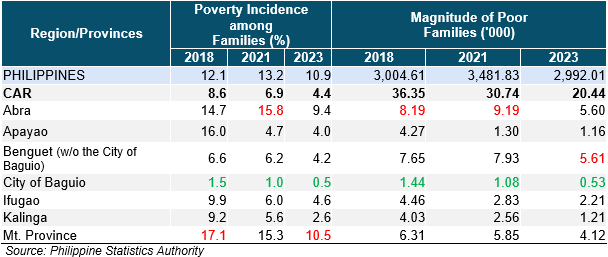
The consistently decreasing poverty incidence in CAR as a whole was also reflected in most of the provinces, except for the province of Abra that experienced a slight increase in poverty incidence among families from 14.7% in 2018 to 15.8% in 2021, which equates to a magnitude of 8.19 thousand families to 9.19 thousand families in the province.
The provinces with the lowest poverty incidence among families for 2023 were the City of Baguio, with a 0.5% poverty incidence, followed by Kalinga with 2.6% and Apayao with 4.0%. The City of Baguio consistently had the lowest poverty incidence in 2018, 2021, and 2023. The province that recorded the highest incidence for 2023 was Mountain Province, with a 10.5% incidence rate, followed by Abra with 9.4% and Ifugao with 4.6%. All of the provinces/HUCs in the region had lower poverty incidences compared to the Philippines in 2023. In terms of incidence rate change in 2023, the provinces with the greatest decrease were Abra, with a decrease in 6.4 percentage points from 15.8% in 2021 to 9.4% in 2023, followed by Mountain Province with a 4.8 percentage points decrease and Kalinga with a 3.0 percentage points decrease.
The decreasing trend in the poverty incidence among families was also paralleled by a decreasing trend in the magnitude of poor families. In 2023, the magnitude in the region was 20.44 thousand families that was 10.30 thousand less than in 2021 with 30.74 thousand families, and 15.91 thousand less than in 2018 with 36.35 families. CAR contributed 0.68% to the total magnitude of poor families for the whole Philippines in 2023.
In terms of the magnitude of poor families in 2023, the province of Benguet recorded the highest with 5.61 thousand families, closely followed by Abra with 5.60 thousand families. The province/HUC with the lowest magnitude was the City of Baguio with around 530 poor families, followed by Apayao with 1.16 thousand families. It is important to note as well the change in the magnitude of poor families in each province between the three different years. Five out of the seven provinces had a consistent downward trend in the magnitude of poor families, except in the provinces of Abra and Benguet; both of which had an increase from 2018 to 2021. The provinces with the greatest decrease in the magnitude of poor families from 2021 were Abra with a decrease of 3.59 thousand families followed by Benguet with 2.32 thousand families.
Poverty incidence and magnitude of poor population on a consistent downward trend in CAR
The region has recorded a decreasing trend in the poverty incidence, starting from a 12.0% rate in 2018, which equates to 12 in 100 Filipinos in CAR having income below the required amount to afford basic food and non-food necessities, to 9.9% in 2021 and finally 7.0% in 2023. This consistent decreasing trend was not wholly present for the case of the country as a whole. The Philippines had a 16.7% incidence rate in 2018, then increased to 18.1% in 2021, but fortunately decreased to 15.5% in 2023.
Figure 2. Poverty Incidence among Population (%), Philippines and CAR:
2018, 2021 & 2023
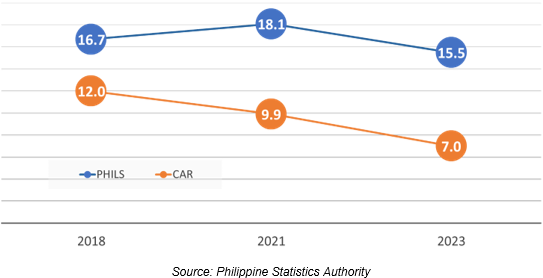
Table 3. Poverty Incidence & Magnitude of Poor Population by Province & HUC, CAR: 2018, 2021 & 2023
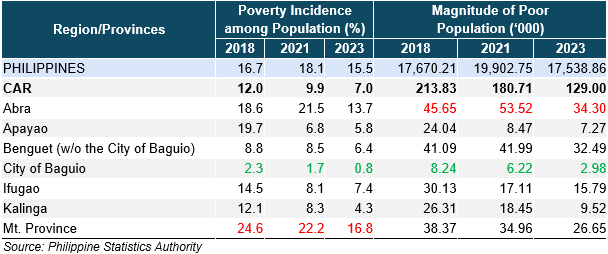
The provinces with the lowest poverty incidence among the population for 2023 were the City of Baguio with an incidence rate of 0.8%, followed by Kalinga with 4.3% and Apayao with 5.8%. The City of Baguio had consistently remained with the lowest incidence rate among population for the years 2018, 2021, and 2023. The provinces with the highest poverty incidences among their population were Mountain Province with 16.8%, followed by Abra with 13.7% and Ifugao with 7.4%. Mountain Province was the only province in CAR that had a higher incidence rate compared to the Philippines, with a 16.8% incidence rate in 2023. In terms of the decrease in rate of the incidence of poverty among population from 2021 to 2023, Abra had the greatest decrease with a 7.8 percentage points decrease, followed by Mountain Province with a 5.4 percentage points and Kalinga with a 4.0 percentage points.
The magnitude of poor population in CAR had also been on a consistent downward trend, with the magnitude being 213,830 in 2018, then decreasing to 180,710 in 2021, and 129,000 in 2023. The Philippines has experienced a different trend; in 2021, the magnitude of poor population was 19,902,750, a 2,232,540 or 12.6% increase compared to 2018. Fortunately, as the country was in the process of recovering, so were the people that resulted in a decrease in the magnitude of poor population, specifically, a 2,363,890 or 11.9% decrease to 17,538,860 magnitude of poor population.
The provinces with the lowest magnitude of poor population were the City of Baguio with a magnitude of 2.98 thousand poor individuals, followed by Apayao with 7.27 thousand, and Kalinga with 9.52 thousand. Only these three provinces and HUC had a magnitude less than 10,000. The provinces with the highest magnitude were the province of Abra with 34,300 poor individuals, followed by Benguet with 32,490 and Mountain Province with 26,650. Despite the province of Abra having the highest magnitude in poor population, it was also the province with the greatest decrease in magnitude from 2021, delisting 19,220 people from being poor. Abra was the only province in 2023 to achieve a decrease in magnitude greater than 10,000. The other provinces with the greatest decrease in magnitude were Kalinga with 8,930 and Mountain Province with an 8,310 decrease.
Food threshold increases but subsistence incidence decreases
The food threshold for the Cordillera was estimated at PhP9,274 monthly or PhP305 daily for a family of five in 2023. This was an increase of PhP1,026 or 12.55% from the year 2021, and PhP2,028 or 27.62% from the year 2018. The threshold of CAR in 2023 was lower than the food threshold of the country estimated at PhP9,274. Overall, the food threshold of the region consistently remained lower compared to the threshold of the country in 2018, 2021, and 2023. Most of the provinces in the region had a lower food threshold when compared to the country in 2023, except Mountain Province with 10.29% higher threshold. The region initially had a higher increase in the food threshold compared to the country, with the region having a 13.39% increase compared to the country with a 10.89% increase from the year 2018 to 2021. However, it was a different case from 2021 to 2023, as the Philippines recorded a 14.55% increase while CAR had 12.55% increase in food threshold.
Table 4. Poverty Incidence & Magnitude of Poor Population by Province & City, CAR: 2018, 2021 & 2023
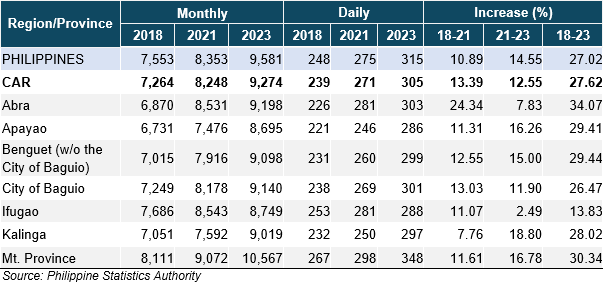
The provinces with the lowest food thresholds in the region in 2023 were Apayao with PhP8,685, followed by Kalinga with PhP9,019 and Benguet with PhP9,098. In contrast, the provinces that listed the highest food thresholds in 2023 were Mountain Province with PhP10,567, followed by Abra with a threshold of PhP9,198 and the City of Baguio with PhP9,140. In terms of the change in the threshold, only two out of the seven provinces and HUC in CAR had recorded a less than 10% increase in the threshold in 2023, specifically the provinces of Ifugao with a 2.49% increase and Abra with a 7.83% increase. The threshold of the City of Baguio increased by 11.9%; and the provinces with the highest increase in the threshold in 2023 were Kalinga with 18.80%, Mountain Province with 16.78%, and Apayao with 16.26%.
Figure 3. Subsistence Incidence among Families (%), Philippines and CAR:
2018, 2021 & 2023
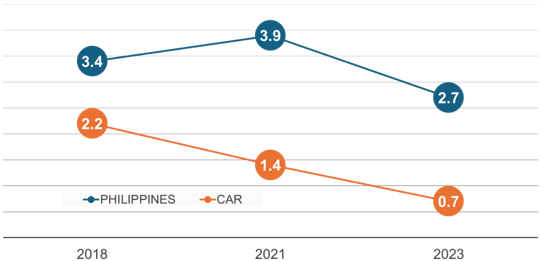
Similar to the trend in the poverty incidence, CAR recorded a lower subsistence incidence among families compared to the Philippines as a whole. The region also had a consistent decreasing subsistence incidence among families, starting from a 2.2% incidence in 2018, to a 1.4% incidence in 2021, and finally at a 0.7% incidence in 2023. The Philippines in contrast started with a 3.4% incidence, climbing up to a 3.9% in 2021, and decreasing back down to 2.7% in 2023.
Table 5. Subsistence Incidence & Magnitude of Subsistence Poor Families by Province & City, CAR: 2018, 2021 & 2023
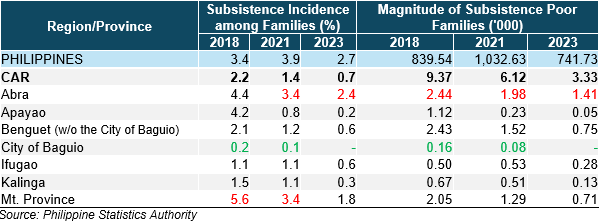
All of the provinces paralleled the consistent downward trend of the subsistence incidence in the region. The provinces with the lowest subsistence incidence among families in 2023 were Apayao with a 0.2% subsistence rate, followed by Kalinga with 0.3%. In contrast, the provinces with the highest subsistence rates were Abra with a 2.4% and Mountain Province with a 1.8%. Please note that the estimate of Baguio City with dash (-) does not pertain to absolute zero and does not categorically mean the non-existence of food poor families.
The only province in CAR that did not follow the consistent downward trend of the region is Ifugao with no significant changes in the subsistence incidence between 2018 and 2021. However, there was still an increase in the number of subsistence poor families in Ifugao, specifically an increase of 30 families from 2018 to 2021. The provinces that had recorded the lowest number of subsistence poor families in the region in 2023 were Apayao with a magnitude of 50, followed by Kalinga with 130. In contrast, the provinces with the highest number of subsistence poor families in the region in 2023 were Abra with a magnitude of 1,410 and Mountain Province with 710. In terms of the change of the magnitude from 2021 to 2023, the provinces with the highest decrease were Benguet, from 1,520 in 2021 down to a 750 in 2023, a decrease of 770 subsistence poor families, followed by Mountain Province, from 1,290 in 2021 to 710 in 2023, a decrease of 580.
Figure 4. Subsistence Incidence among Population (%), Philippines and CAR: 2018, 2021 & 2023
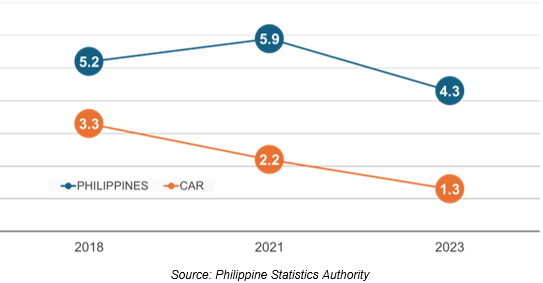
The trend of the subsistence incidence among families parallels that of the subsistence incidence among population. CAR had 3.3% subsistence incidence among population in 2018, dropped down to 2.2% subsistence incidence in 2021, then finally 1.3% in 2023. The Philippines initially recorded 5.2% subsistence incidence among its population, then increased to 5.9% in 2021, and decreased to 4.3% in 2023.
Table 6. Subsistence Incidence among Population & Magnitude of Subsistence Poor Population by Province & City, CAR: 2018, 2021 & 2023
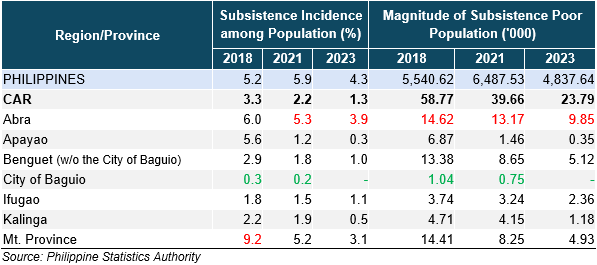
All of the provinces and HUC within the region also had decreasing subsistence incidences among population. Furthermore, all of the provinces and HUC had lower subsistence incidences among population compared to the whole country. The provinces with the lowest recorded subsistence incidence among population in 2023 were Apayao with a subsistence incidence of 0.3% followed by Kalinga with 0.5%. On the other hand, the provinces with the highest recorded subsistence incidences in 2023 were Abra with 3.9% and Mountain Province with 3.1%. Again, the estimate of Baguio City with dash (-) does not pertain to absolute zero and does not categorically mean the non-existence of food poor individuals.
In 2023, the magnitude of subsistence poor population in CAR was around 23,790, a decrease of 40.01% from 2021. It also contributed around 0.49% to the total number of subsistence poor population of the Philippines estimated at around 4,837,640 Filipino individuals. The provinces with the lowest magnitude were Apayao with 350 food poor individuals followed by Kalinga with 1,180. The provinces with the highest magnitude of subsistence poor or food poor individuals were Benguet with 5,120 followed by Mountain Province with 4,930. In terms of the change in magnitude, the provinces with the highest decrease in the magnitude from 2021 to 2023 were Benguet with a 3,530-decrease followed by a tie with Abra and Mountain Province with a 3,320 decrease each.
Groupings, Income Gap & Poverty Gap
The poverty incidence among families could be classified into one of six groups, each with each group indicating the interval of the percentage of poverty incidence of the province. The Cordillera region initially had three out of seven provinces classified under group 5, namely the provinces of Abra, Apayao, and Mountain Province, with the other remaining provinces being classified under group 6. This means that three provinces had a poverty incidence among families being greater than 10% but less than 20%. In 2021, the province of Apayao moved up to group 6 from group 5 as its poverty incidence decreased significantly. In the year 2023, the province of Abra moved up to group 6 as its incidence decreased from 15.8% in 2021 to 9.4% in 2023, leaving six out of seven provinces and HUC being classified under group 6.
Table 7. Grouping of Provinces and HUC based on 2023 Full Year Poverty Incidence among Families, by Province: 2018, 2021, and 2023
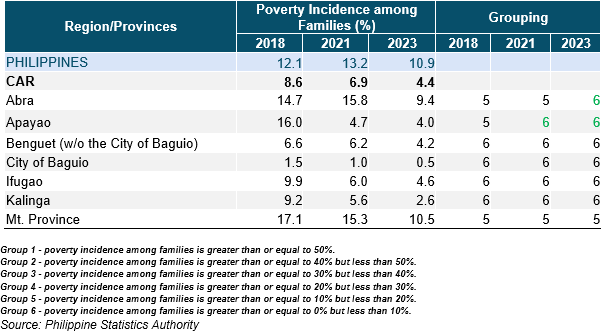
Table 8. Income Gap by Province and Highly Urbanized City, CAR:
2018, 2021, and 2023
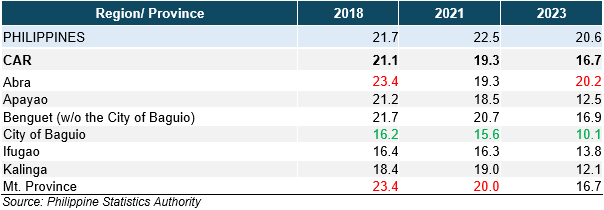
The income gap measures the disparity in income distribution across a population. It shows the difference between the highest earners and the lowest earners. The income gap of the region had also been getting narrower, starting from 21.1 in 2018 to 19.3 in 2021, and finally at 16.7 in 2023. This value in 2023 was a decrease of 2.3 percentage points from 2021 to 2023, and 4.4 percentage points for 2018 to 2023. The income gap of the Philippines was recorded at around 21.7 in 2018, which then increased to 22.5 in 2021, and decreased to 20.6 in 2023. The income gap of the region remained lower than that of the Philippines.
The provinces with the lowest income gaps in 2023 were the City of Baguio with a gap of 10.1, followed by Kalinga with 12.1 and Apayao with 12.5. In contrast, the provinces with the highest income gaps were Abra with 20.2, followed by Benguet with 16.9 and Mountain Province with 16.7. In terms of the change in the income gap from 2021 to 2023, the province with the highest decrease is Kalinga with a decrease of 6.9 percentage points.
Table 9. Poverty Gap by Province and Highly Urbanized City, CAR:
2018, 2021, and 2023
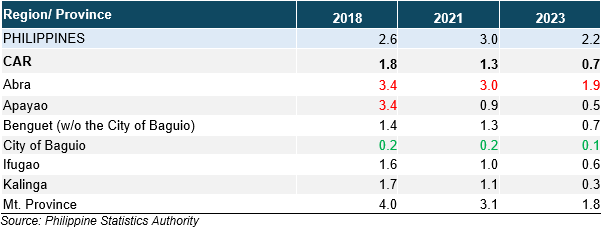
The poverty gap measures the intensity of poverty. It shows how far below the poverty line the average income of the poor population falls. The poverty gap of the region had also been on a downward trend, from 1.8 in 2018 down to 1.3 in 2021, and decreasing again to 0.7 in 2023. The income gap of the Philippines started with 2.6 in 2018, climbing up to 3.0 in 2021, and decreasing back to 2.2 in 2023. The poverty gap of the region had remained lower than that of the Philippines.
City of Baguio recorded the lowest poverty gap n with 0.1, followed by Kalinga with 0.3 and Apayao with 0.5. In contrast, the provinces with the highest poverty gaps were Abra with 1.9, followed by Mountain Province with 1.8 and Benguet with 0.7. In terms of the change in the poverty gap from 2021 to 2023, the province with the highest decrease in the poverty gap was Mountain Province with a 1.3 percentage point decrease, followed by Abra with a 1.1 percentage point and Kalinga with a 0.8 percentage point decrease.
(SGD)
VILLAFE P. ALIBUYOG
Regional Director
Technical Notes
Food Threshold refers to the minimum income required for a family/ individual to meet the basic food needs, which satisfies the nutritional requirements for economically necessary and socially desirable physical activities. Also referred to as the subsistence threshold or the food poverty line.
Income Gap refers to the average income shortfall, expressed in proportion to the poverty threshold, of families/individuals with income below the poverty threshold.
Poor refers to individuals and families whose income fall below the poverty threshold as defined by the National Economic and Development Authority and/or cannot afford in a sustained manner to provide their minimum basic needs of food, health, education, housing and other essential amenities of life (R.A. 8425).
Poverty Gap refers the total income/ expenditure shortfall (expressed in proportion to the poverty threshold) of families/ individuals with income/ expenditure below the poverty threshold, divided by the total number of families/ individuals.
Poverty Incidence refers to the proportion of families/individuals with per capita income/expenditure less than the per capita poverty threshold to the total number of families/individuals.
Poverty Threshold refers to the minimum income required for a family/individual to meet the basic food and non-food requirements.
Subsistence Incidence refers to the proportion of families/individuals with per capita income/expenditure less than the per capita food threshold to the total number of families/individuals.


